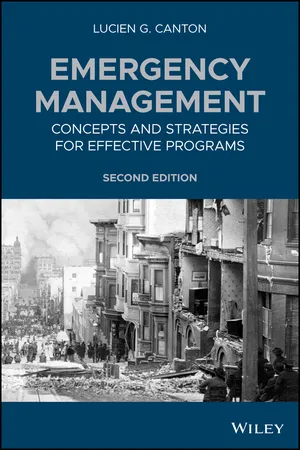
- English
- ePUB (mobile friendly)
- Available on iOS & Android
About this book
Provides a comprehensive examination of emergency management and offers concepts and strategies for creating effective programs
This book looks at the larger context within which emergency management response occurs, and stresses the development of a program to address a wide range of issues. Not limited to traditional emergency response to natural disasters, it addresses a conceptual model capable of integrating multiple disciplines and dealing with unexpected emergencies.
Emergency Management: Concepts and Strategies for Effective Programs, Second Edition starts by focusing on the three pillars on which successful emergency management is based: an understanding of history, knowledge of social science research, and technical expertise in emergency management operations. It provides insight as to how emergency management has evolved and suggests reasons why the current method of response planning doesn't work as well as it should. The book then goes on to discuss establishing and administering the emergency management program. It looks at the analysis of risk as the basis for strategy development, and considers both the traditional macro view of hazard identification and analysis as well as the micro view required for continuity planning. Strategy development is examined next, followed by coverage of planning process, techniques and methods. The book finishes with chapters on coordinating response, leading in crisis, and crisis management.
- Features two new chapters on the development of national response strategy and leadership in a crisis
- Incorporates the Principles of Emergency Management adopted by many emergency management professional associations and agencies
- Encourages the development of an enterprise wide program to address a wide range of potential threats
- Covers the various phases of comprehensive emergency management
- Integrates academic research with practical experience and case studies
Emergency Management: Concepts and Strategies for Effective Programs is an important book that will benefit students, law enforcement, and state and local emergency managers and planners involved in emergency management.
Frequently asked questions
- Essential is ideal for learners and professionals who enjoy exploring a wide range of subjects. Access the Essential Library with 800,000+ trusted titles and best-sellers across business, personal growth, and the humanities. Includes unlimited reading time and Standard Read Aloud voice.
- Complete: Perfect for advanced learners and researchers needing full, unrestricted access. Unlock 1.4M+ books across hundreds of subjects, including academic and specialized titles. The Complete Plan also includes advanced features like Premium Read Aloud and Research Assistant.
Please note we cannot support devices running on iOS 13 and Android 7 or earlier. Learn more about using the app.
Information
Table of contents
- Cover
- Table of Contents
- PREFACE TO THE SECOND EDITION
- PREFACE TO THE FIRST EDITION
- INTRODUCTION
- Chapter 1: HISTORICAL PERSPECTIVES: THE EVOLUTION OF EMERGENCY MANAGEMENT
- Chapter 2: HISTORICAL PERSPECTIVEs: TOWARD A NATIONAL RESPONSE STRATEGY
- Chapter 3: SOCIAL SCIENCE AND THE BEGINNINGS OF EMERGENCY MANAGEMENT THEORY
- Chapter 4: THE EMERGENCY MANAGER: EVOLVING ROLES AND SHIFTING PARADIGMS
- Chapter 5: ESTABLISHING THE EMERGENCY MANAGEMENT PROGRAM
- Chapter 6: ASSESSING RISK
- Chapter 7: DEVELOPING STRATEGY
- Chapter 8: PLANNING CONCEPTS
- Chapter 9: PLANNING TECHNIQUES AND METHODS
- Chapter 10: COORDINATING RESPONSE
- Chapter 11: LEADING IN CRISIS
- Chapter 12: CRISIS MANAGEMENT
- CONCLUSION
- Bibliography
- Index
- End User License Agreement